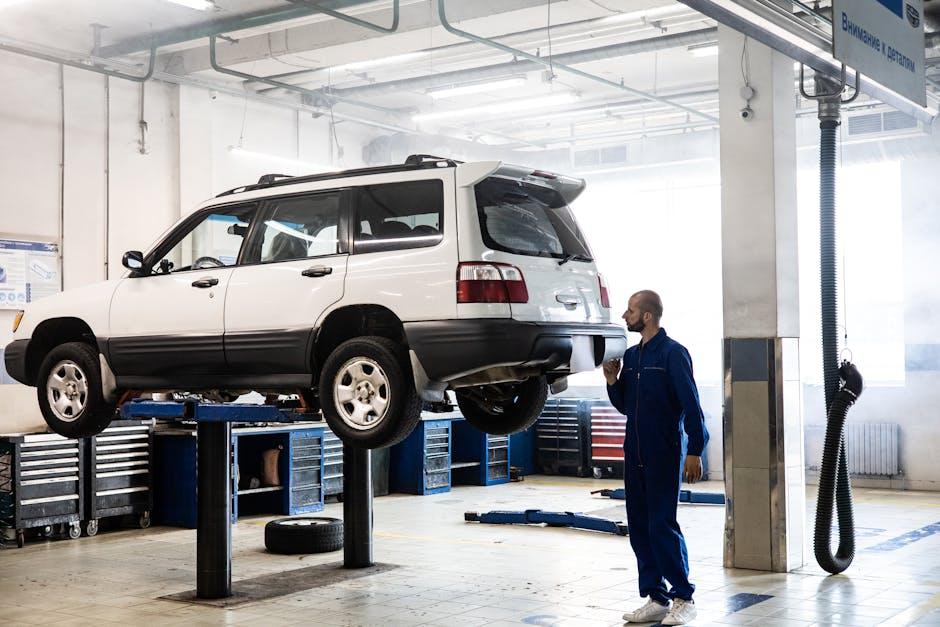In the intricate symphony of moving parts that make up a vehicle, the engine stands as the heart, tirelessly powering every journey. Yet, beneath its rhythmic hum lies a complex network of systems that can falter without warning. This is where engine diagnostics come into play—an essential tool that delves beneath the surface, translating mechanical whispers and electronic signals into actionable insights. Understanding what an engine diagnostic entails and why it matters not only empowers vehicle owners to maintain optimal performance but also safeguards the longevity and safety of their rides. In this article, we explore the world of engine diagnostics, unraveling how this invisible hand guides drivers and mechanics alike through the maze of automotive health.
Table of Contents
- Understanding Engine Diagnostics and Its Core Functionality
- Common Symptoms That Signal the Need for a Diagnostic Check
- How Modern Diagnostic Tools Enhance Vehicle Performance
- The Role of Engine Diagnostics in Preventative Maintenance
- Interpreting Diagnostic Results for Informed Decision Making
- Best Practices for Choosing a Reliable Diagnostic Service
- Q&A
- The Way Forward

Understanding Engine Diagnostics and Its Core Functionality
Engine diagnostics serve as the vehicle’s early warning system, utilizing advanced technology to pinpoint issues before they escalate into costly repairs or breakdowns. By tapping into the engine’s computer system, mechanics and car owners gain access to real-time data, unveiling hidden problems hidden deep within the engine’s components. This smart inspection method is invaluable because it not only detects mechanical faults but also identifies software glitches, sensor errors, and emissions irregularities, ensuring that your car runs smoothly and efficiently.
Understanding what engine diagnostics reveal can simplify decisions about maintenance and repairs. Here’s what professional diagnostic tools typically assess:
- Fault Codes: Standardized trouble codes that indicate system malfunctions.
- Live Sensor Data: Real-time performance metrics such as temperature, pressure, and fuel mixture.
- Emission Control: Status of systems designed to minimize environmental impact.
- System Health: Overall operational status of major engine subsystems.
| Diagnostic Parameter | What It Checks | Why It’s Important |
|---|---|---|
| OBD-II Codes | Error messages from engine control unit | Quick fault identification |
| Fuel Efficiency | Fuel consumption and mixture ratios | Optimizes performance and costs |
| Emission Levels | Pollutant release metrics | Ensures environmental compliance |
| Sensor Integrity | Functionality of sensors like oxygen or mass airflow | Prevents engine mismanagement |

Common Symptoms That Signal the Need for a Diagnostic Check
When your vehicle starts acting up, it’s often trying to tell you something’s wrong beneath the surface. Dashboard warning lights such as the check engine light, ABS, or oil pressure indicator should never be ignored as they are your car’s first line of communication about potential issues. Additionally, if you notice symptoms like rough idling, stalling, or a sudden drop in fuel efficiency, these subtle clues signal that it might be time for a detailed diagnostic scan to accurately pinpoint the problem before it escalates.
Other common signs include unusual noises or vibrations, especially during acceleration or braking, and difficulty starting the engine. Modern diagnostics can detect irregularities in various systems, so even if the symptoms seem minor, a timely check can save you from costly repairs down the line. Below is a quick reference guide highlighting frequent symptoms and their possible implications:
| Symptom | Potential Cause | Why a Diagnostic Check Helps |
|---|---|---|
| Check Engine Light | Sensor malfunction, emissions issues | Identifies specific fault codes for targeted repairs |
| Rough Idling | Ignition problems, fuel system issues | Detects misfires or air-fuel imbalances |
| Decreased Fuel Efficiency | Clogged filters, faulty injectors | Analyzes fuel system performance |
| Unusual Noises | Engine wear, exhaust leaks | Assesses mechanical integrity and exhaust flow |

How Modern Diagnostic Tools Enhance Vehicle Performance
Modern diagnostic tools have revolutionized the way mechanics and car owners approach vehicle maintenance, allowing for unparalleled insight into an engine’s health. These sophisticated devices connect directly to your car’s computer system, instantly retrieving detailed information on everything from fuel efficiency to emission levels. By interpreting error codes and sensor data, technicians can swiftly pinpoint issues that would otherwise require time-consuming manual inspections. This not only reduces repair times but also ensures that minor problems are addressed before they evolve into costly repairs, ultimately extending the vehicle’s lifespan.
Beyond troubleshooting, advanced diagnostics contribute significantly to performance optimization. They provide a real-time snapshot that helps fine-tune engine parameters, enhancing fuel economy, power output, and overall drivability. Key benefits include:
- Improved Fuel Efficiency through precise fuel-air mixture adjustments
- Reduced Emissions by monitoring exhaust systems and catalytic converters
- Enhanced Safety via early detection of critical system failures
- Preventive Maintenance guided by detailed reports on component wear
| Diagnostic Feature | Performance Impact |
|---|---|
| Oxygen Sensor Analysis | Optimizes combustion efficiency |
| Ignition Timing Adjustment | Maximizes engine power |
| Emission Control Monitoring | Meets environmental regulations |
| Fuel Injection Calibration | Ensures smooth acceleration |

The Role of Engine Diagnostics in Preventative Maintenance
Engine diagnostics serve as the automotive crystal ball, allowing mechanics and vehicle owners to anticipate and prevent mechanical failures before they escalate into costly repairs. By utilizing advanced scanning tools, the vehicle’s computer systems reveal hidden issues such as sensor malfunctions, fuel inefficiencies, and emission irregularities. This proactive insight not only enhances performance but also preserves the engine’s lifespan, ensuring your vehicle runs smoothly and reliably across countless miles.
Incorporating routine diagnostic checks into your maintenance schedule empowers you to make informed decisions backed by data. Regular diagnostics help identify subtler problems early on, such as deteriorating components or software glitches, which may not yet trigger warning lights. Consider this table highlighting key benefits of engine diagnostics in preventative care:
| Benefit | Impact |
|---|---|
| Early Fault Detection | Minimizes breakdown risk |
| Fuel Efficiency Monitoring | Reduces fuel consumption |
| Emission Control | Ensures environmental compliance |
| Cost Savings | Prevents expensive repairs |
- Predictive maintenance: Stay ahead of engine wear and tear.
- Safety assurance: Address critical issues before they compromise safety.
- Optimized performance: Maintain smooth engine operation and response.

Interpreting Diagnostic Results for Informed Decision Making
Understanding the results from an engine diagnostic can feel overwhelming, but breaking down the information helps you make wiser decisions. These diagnostics aren’t just a jumble of codes—they’re a window into your vehicle’s health. For instance, when a diagnostic tool flags an error code, it can indicate anything from a minor sensor glitch to a serious engine malfunction. Prioritizing which issues to address immediately and which can wait hinges on interpreting this data correctly. This ensures you avoid costly repairs later and maintain optimal engine performance.
When reviewing your diagnostic report, focus on key indicators such as:
- Error codes: Pinpoint specific malfunction areas quickly.
- Pending codes: Flags potential issues not yet critical.
- Freeze frame data: Snapshots of engine conditions at error time.
- Live data streams: Real-time sensor outputs showing ongoing performance.
| Result Type | What It Means | Recommended Action |
|---|---|---|
| Error Code P0420 | Catalytic converter efficiency low | Inspect exhaust system, consider replacement |
| Pending Code P0300 | Random/multiple cylinder misfire | Monitor and retest after driving |
| Freeze Frame | Engine ran rich at 2500 RPM | Check fuel injection system |
By translating these results into clear actions, you empower yourself to keep your engine running smoothly and extend the life of your vehicle. Working closely with a technician who can interpret these details can amplify your understanding, ensuring every repair or maintenance step is informed and genuinely necessary.

Best Practices for Choosing a Reliable Diagnostic Service
When selecting a diagnostic service, prioritizing expertise and technology ensures accurate results that save time and money. Look for providers utilizing the latest scanning tools compatible with a wide range of vehicle makes and models. Experienced technicians familiar with your car brand offer invaluable insights, helping to identify underlying issues instead of just symptoms. Transparency in reporting and clear communication also set reliable services apart, allowing you to make informed decisions about necessary repairs.
Consider these key factors:
- Certification and Training: Ensure technicians hold up-to-date certifications.
- Advanced Diagnostic Equipment: Services should invest in modern, comprehensive scanners.
- Customer Reviews and Reputation: Positive feedback often reflects consistent quality.
- Detailed Reporting: Look for providers offering clear, understandable diagnostic reports.
| Criteria | Why It Matters | What to Look For |
|---|---|---|
| Certification | Ensures skill level and knowledge | ASE or manufacturer-specific certifications |
| Equipment | Accurate and fast diagnostics | State-of-the-art scan tools |
| Reputation | Reflects reliability and customer satisfaction | Verified customer reviews and referrals |
| Communication | Clarity about vehicle condition and next steps | Detailed explanations and reports |
Q&A
Q: What exactly is an engine diagnostic?
A: An engine diagnostic is like a high-tech health check for your car’s engine. Using specialized tools and computer software, mechanics can access your vehicle’s onboard computer to identify any issues or irregularities. It’s a way to peek under the hood without lifting it, revealing hidden problems before they become costly headaches.
Q: How does an engine diagnostic work?
A: Modern cars are equipped with sensors that continuously monitor the engine’s performance. When something goes wrong—like a misfiring spark plug or a faulty oxygen sensor—the car’s computer records an error code. Engine diagnostic tools read these codes and translate them into understandable information, guiding mechanics to the root cause.
Q: Why is an engine diagnostic important?
A: Think of engine diagnostics as preventative medicine for your vehicle. Catching problems early can save you from bigger repairs down the line, improve fuel efficiency, and keep your car running smoothly. It’s also essential for passing emissions tests and maintaining overall safety on the road.
Q: When should I get an engine diagnostic test?
A: If your check engine light flickers on, or if you notice unusual noises, reduced power, or strange smells, it’s a good time for a diagnostic test. Even if your car seems fine, routine diagnostics during scheduled maintenance can help catch silent issues before they grow.
Q: Can I perform an engine diagnostic myself?
A: With the rise of affordable OBD-II scanners, DIY enthusiasts can now perform basic diagnostics at home. However, interpreting the results and deciding on the right fix often requires professional expertise.
Q: Does an engine diagnostic only apply to cars?
A: While commonly associated with cars, engine diagnostics apply to any vehicle or machinery equipped with electronic monitoring systems, including trucks, motorcycles, boats, and even some lawn equipment.
Q: How long does an engine diagnostic take?
A: The diagnostic scan itself often takes just a few minutes. However, identifying the problem and performing necessary repairs can take longer, depending on complexity.
Q: Can an engine diagnostic improve my car’s resale value?
A: Absolutely. Providing a diagnostic report to prospective buyers demonstrates that the vehicle has been well cared for, fostering trust and potentially increasing resale value.
Q: What if the diagnostic reveals multiple issues?
A: Don’t panic. The engine diagnostic is a roadmap showing what needs attention. Prioritizing repairs based on severity and budget helps you tackle problems systematically, keeping your vehicle safe and reliable.
The Way Forward
In the intricate dance of metal and motion that powers our vehicles, the engine diagnostic serves as both a compass and a detective—guiding us through complexities and uncovering hidden clues beneath the hood. Understanding what an engine diagnostic is and why it matters empowers every driver to take a proactive stance in maintaining their vehicle’s health, efficiency, and longevity. In a world where technology evolves rapidly, embracing these diagnostic insights is not just about fixing problems; it’s about forging a smoother, safer journey ahead. Ultimately, the engine diagnostic is more than a tool—it’s a window into the heart of your car, inviting you to listen closely and respond wisely.

